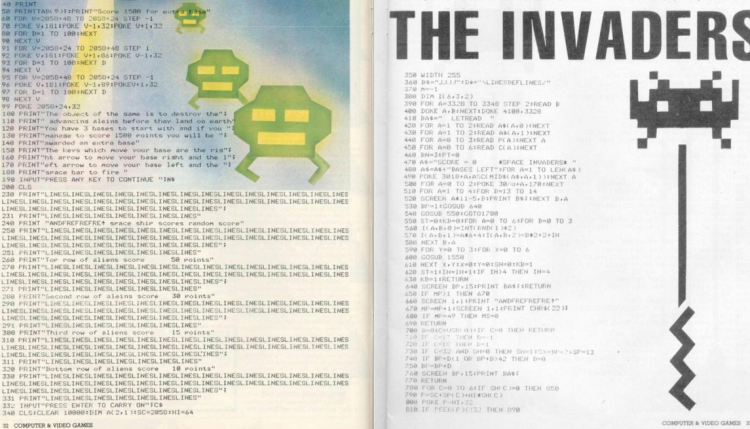
10 PRINT “Type-in listings rule”
DATA 34,69,23,255,0,255,128,55,34,87,39,67,33,20,50,67………………..
Ah, the type-in. For a legion of thirtysomethings they were a staple part of their computer-owning teenage diet in the 1980s. Who (over 35) hasn’t spent hours hunched over a keyboard, entering page after page of BASIC and machine code DATA statements, using a ruler to keep track of your progress as you worked through the listing?
![]() Type-ins coveted many specialist computer and gaming publications as well as spawning dedicated listing books. Programs covered every genre popular in the day; arcade clones, text adventures, sports sims, maze games and platformers. They were often crude, slow and full of bugs, but being able to type them in yourself and see the end result on screen was part of the magic.
Type-ins coveted many specialist computer and gaming publications as well as spawning dedicated listing books. Programs covered every genre popular in the day; arcade clones, text adventures, sports sims, maze games and platformers. They were often crude, slow and full of bugs, but being able to type them in yourself and see the end result on screen was part of the magic.
Their popularity was bolstered by their cheapness and accessibility. For a fraction of the price of a commercial game, a book promised 10, 50 or even 100 “amazing”, “instant” and “write your own” programs for your microcomputer. Unfortunately the games were some hideous travesty where the blurb and the hand drawn illustration promised more than they delivered.
In magazines, easily filling space must have appealed to many editors, but type-ins also fulfilled a need. Many hints and tips sections were festooned with self-entered POKES that replaced or modified a commercial game’s loader and embellished the player with infinite lives or ammo. Many magazines ran supplements – “The Big Book of Games” from Computer & Video Games for example, that if you were lucky included a few absolute corkers from coding geniuses like the Oliver Twins, Jeff Minter and John Twiddy. It was even suspected that canny Editors deliberately sabotaged listings with bugs. After all, it was a great way to get little Johnny to part with another £1 the following month when he noticed the “fix” was included to make that malfunctioning code work!
Perhaps the greatest reason for their success, and one that we miss today, was the standardisation of the BASIC language across every home computer. With enough tweaking you could get Spectrum listing working on a Commodore or Amstrad, with some books including the alterations to the standard listings you had to make for other computers.
![]() Most of these memorable books were provided by Peter Usborne’s publishing empire. He recognised the gap in the market and Usborne Computer Books were the first technical books written for the home. Lisa Watts, Digital Director at Usborne recalls “we were immensely excited when we got our first ZX81 in the office and realised the power it gave children to write their own programs and make something happen on a TV screen.” Between 1982 and 1984 over 35 computing books were published, each adhering to the Usborne brand of colourful info-packed tomes, liberally sprinkled with glorious illustrations and meticulous attention to detail. Watts continues “we spent hours typing up, proof reading and testing the programs. One typo would prove fatal! The results were of course extremely simple, but the book graphics conjured up scene and atmosphere.” Many of us can recall with fondness, tootling back and forth to school or town library feeding off Usborne books. It’s quite amazing that last marked their 40th Anniversary year in publishing.
Most of these memorable books were provided by Peter Usborne’s publishing empire. He recognised the gap in the market and Usborne Computer Books were the first technical books written for the home. Lisa Watts, Digital Director at Usborne recalls “we were immensely excited when we got our first ZX81 in the office and realised the power it gave children to write their own programs and make something happen on a TV screen.” Between 1982 and 1984 over 35 computing books were published, each adhering to the Usborne brand of colourful info-packed tomes, liberally sprinkled with glorious illustrations and meticulous attention to detail. Watts continues “we spent hours typing up, proof reading and testing the programs. One typo would prove fatal! The results were of course extremely simple, but the book graphics conjured up scene and atmosphere.” Many of us can recall with fondness, tootling back and forth to school or town library feeding off Usborne books. It’s quite amazing that last marked their 40th Anniversary year in publishing.
All good things must come to an end though, and as consoles exploded, cover-mounted cassettes became cost-effective and more powerful computers appeared the type-in faded into obscurity. But as Associate Professor of Digital Media at MIT and co-author of the book “10-PRINT”, Nick Montfort comments – type-ins are not nostalgia or trivial of a lost era; “This type of program was written and run by millions in the 1980s on their way to a deeper understanding of computers” he says.
10 PRINT “Ahem to that.”
20 GOTO 10
(article written by Mark Hardisty)

Tim Cooper 16th December 2014 - 12:24 pm
I had that book! Aside from the one that came with my speccy, that was the first programming book I ever owned. Ahhh, happy memories, sat on the floor in the lounge in front of our 14″ TV, tapping away for hours to try and make a game!